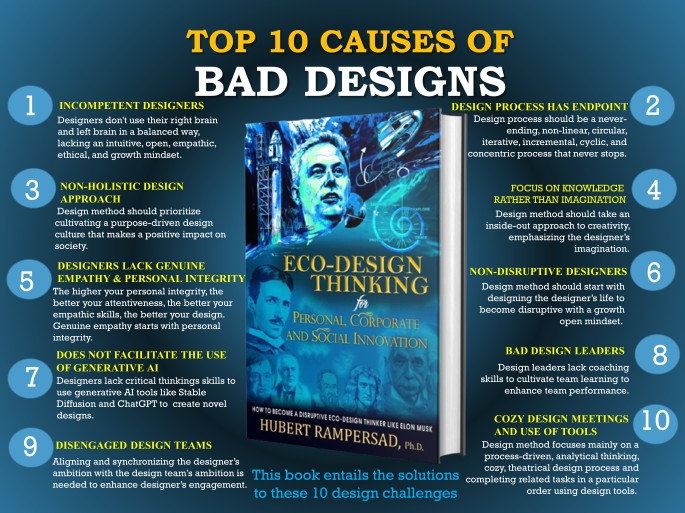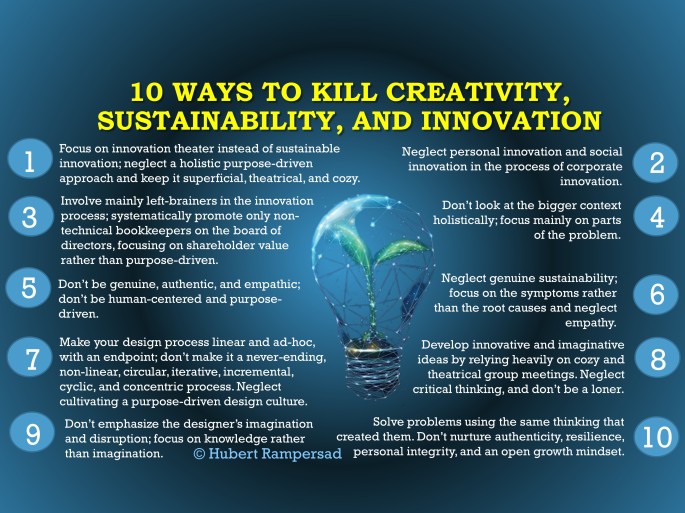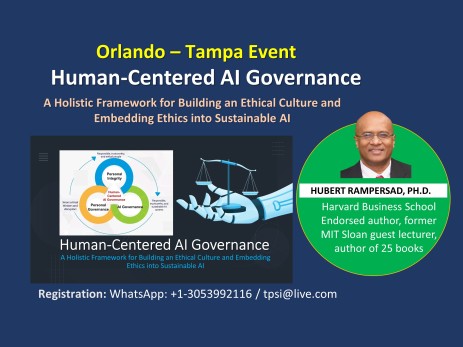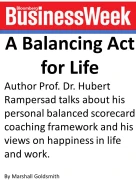How to Fix It
Hubert Rampersad, Ph.D.
The article discusses the challenges that STEM higher education faces in the era of artificial intelligence. STEM (Science, Technology, Engineering, and Mathematics) encompasses various disciplines for solving complex problems. Science provides the As a foundation for understanding the natural world, technology applies scientific knowledge for practical purposes, engineering designs, and builds innovative solutions. Mathematics provides the language to quantify and analyze these solutions. Universities and colleges often perceive STEM education as hype and poorly implemented. It does not guarantee a successful career, as it fails to integrate science, technology, engineering, and mathematics into a cohesive, interdisciplinary whole holistically.
As a foundation for understanding the natural world, technology applies scientific knowledge for practical purposes, engineering designs, and builds innovative solutions. Mathematics provides the language to quantify and analyze these solutions. Universities and colleges often perceive STEM education as hype and poorly implemented. It does not guarantee a successful career, as it fails to integrate science, technology, engineering, and mathematics into a cohesive, interdisciplinary whole holistically.
Unfortunately, STEM education falls short in the generative artificial intelligence (AI) and artificial general intelligence (AGI) era. One reason is that students learn Science, Technology, Engineering, and Mathematics in separate subjects rather than in a holistic context. STEM graduates often lack the integrated creative, imaginative, empathetic, critical thinking, agility, and emotional intelligence skills and vision required to add value to AI and AGI. Read “Cultivating Critical Thinking in the Age of AI”.
critical thinking, agility, and emotional intelligence skills and vision required to add value to AI and AGI. Read “Cultivating Critical Thinking in the Age of AI”.
Additionally, universities do not teach things about sustainability, innovation, and creativity. Finally, AI and AGI will take over many STEM jobs, leaving many STEM graduates without work. Nobel Prize winner Christopher Pissarides has warned that STEM workers in specific IT jobs risk sowing their “own seeds of self-destruction” by promoting AI that will eventually take over their jobs. Therefore, STEM careers are no longer guaranteed with the arrival of AI and AGI. Read also “Why pushing STEM majors is turning out to be a terrible investment.”
In the current era of AI/AGI, job security is a growing concern for many. However, certain professions will always be in demand due to their inherent people-oriented nature. These jobs require a human touch that technology cannot replicate. These jobs include healthcare professionals, artists, hospitality workers, designers, and other positions that require creativity, integrity, authenticity, critical thinking, and empathy. There will always be a demand for these jobs. AI and AGI are transforming industries, improving efficiency and productivity, and pushing the boundaries of what is possible. As a result, the job market is evolving, and while some jobs will be automated, new opportunities will emerge. Due to the current STEM programs in universities and colleges, many STEM graduates may miss out on these opportunities.
AI and AGI are transforming the world and profoundly impacting people’s lives by solving society’s most critical challenges. However, the pace of these developments is slowed by some issues, such as data access, algorithmic bias, ethics and transparency, and legal liability. They sometimes draw wrong conclusions from data, confuse fact and fiction, and present a half-baked mixture as the truth. Due to these shortcomings, we don’t maximize AI/AGI benefits. To maximize the benefits of AI/AGI, it is essential to improve algorithms and datasets, make AI and AGI purpose-driven and human-centered, and embed human-centered AI governance to transform society for the better.
shortcomings, we don’t maximize AI/AGI benefits. To maximize the benefits of AI/AGI, it is essential to improve algorithms and datasets, make AI and AGI purpose-driven and human-centered, and embed human-centered AI governance to transform society for the better. Unfortunately, most STEM people may lack the skills to contribute to this transformation.
Unfortunately, most STEM people may lack the skills to contribute to this transformation.
STEM failures
STEM higher education has failed to nurture the holistic, authentic, and imaginative qualities essential for tomorrow’s engineers and AI systems. The harmful consequences of numerous poorly designed products that did not consider a holistic approach, sustainability, resilience, empathy, critical thinking, authenticity, and personal integrity are also evident. For instance, Elon Musk’s $3 billion Mars rocket failure, Boeing’s 737 Max airplane disaster, and the doomed Titan sub tragedy could have been avoided if a holistic approach had been taken, read “ Top-10 Causes of Bad Designs.

Stockton Rush, the CEO of OceanGate, received a STEM education from Princeton and Berkeley. While I also have a STEM education, I have developed my emotional, spiritual, ethical, critical thinking, and imaginative skills holistically and sustainably after my formal STEM education. You can check my CV for more details. Another example of the failing STEM program is the end of the STEM-related design thinking era, as reported by Fast Company: “ Design giant Ideo cuts a third of the staff and closes offices as the era of design thinking ends.” Design thinking is a problem-solving approach used at MIT and Stanford since the 1990s. However, engineering colleges and universities today do not commonly teach the skills that future engineers and AI/AGI systems need. Engineers must possess empathy, integrity, creativity, imagination, agility, critical thinking, and sustainability holistically and not separately to become visionary and innovative entrepreneurial leaders or aid AI and AGI. Read “ Why Creativity Sucks“.
Why Creativity Sucks“.
These skills are not typically associated with engineering, but the rapid rate of technological change has made most college and university courses obsolete by the time students graduate. STEM education gives engineers separate insights into science, technology, engineering, and mathematics. However, they often fail to nurture the holistic, authentic, and imaginative qualities essential for tomorrow’s engineers and AI systems. Read my articles “The End of Design Thinking: Cultivating a Purpose-Driven Design Culture to Fix the World” and “ We Need a New Generation of Brilliant Engineers.”
The future of work involves humans working together alongside AI/AGI to perform tasks more efficiently and ethically. To prepare for this, universities and colleges must offer STEM education programs that are holistic, sustainable, and tailored to these new needs. Organizations must also reskill and upskill their workforce to ensure individuals have the necessary skills to thrive in this AI/AGI-powered future. The focus must now be on problem-solving, critical thinking, cultivating resilience, authenticity, and integrity, and stimulating creativity, imagination, innovation, self-learning, self-discipline, and curiosity. A holistic and sustainable STEM higher education program will make STEM careers future-proof and adaptable to unpredictable circumstances. Read also “10 Ways to Kill Creativity, Sustainability, and Innovation” .

And Building a Purpose-Driven Design Culture in Tech Companies.

and “How to Restore the Higher Purpose of American Higher Education”.

You may consider attending his Orlando-Tampa Live Events:
Building a Purpose-Driven Design Culture in Tech Companies
We also offer the Certified Authentic AI Leadership Coaching program. This program is appropriate for AI leaders, managers, and professionals who wish to strengthen their ethical leadership and critical thinking skills, drive their purpose and human-centeredness, and coach others to realize the same.
Hubert Rampersad, Ph.D., founded the Center of Excellence in Human-Centered and Purpose-Driven AI Innovation in Orlando. He is a Dutch-American visionary leader in innovative solutions for genuine sustainability, disruptive design innovation, critical thinking in the age of AI, human-centered and purpose-driven AI, and entrepreneurial leadership. He holds a Ph.D. in Innovation Sciences, an MSc in Technology Engineering & Robotics, and a BSc in Mechanical Engineering from leading accredited universities in the Netherlands (Delft University of Technology, Eindhoven University of Technology). He is a well-known futurist, advocating for genuine sustainability on a global scale. With extensive knowledge and expertise, he has authored 25 books on the topics above in many languages and is highly regarded for his insights in these fields. One of his books, “Total Performance Scorecard,” has been published in 20 languages. Dorothy Leonard, an innovation professor at Harvard Business School, wrote the book’s foreword. Rampersad has also previously served as a guest lecturer at MIT Sloan and was featured in BusinessWeek. He was a senior design innovation coach at ASML, the most important tech company in the world and “Europe’s most valuable tech firm“.

Orlando, Florida | tpsi@live.com | Phone/WhatsApp: +13053992116







